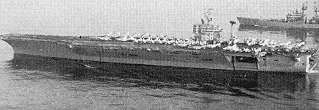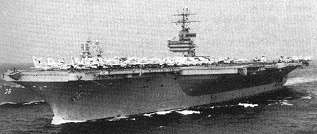How fast are US nuclear aircraft carriers?
From time to time, on sci.military.naval, we are regaled with claims that US Aircraft carriers are capable of speeds reaching into the realms of total fantasy - some of the latest attributing speeds well in excess of 100 knots to these behemoths. Most of the authors have no idea of what power it would take to attain these velocities - but usually are adamant that they have a reliable witness (normally a grizzled old chief) who was on the bridge when the log/gps registered the speed. Further to their ignorance of hull-powering is their naive assumption that powerplant machinery would not grow to a size too large to be contained within the hull. And the weight be too large for the hull to support. I will briefly try to address these matters here. I must emphasize that what I am dealing with is informed conjecture. I do not have the results of measured mile trials for a carrier available. The data as to power and hull I have used are those popularly available in publications since the 1950's for the older vessels through to the latest. In the previous section I used this example on purpose as the parameters equate to that of a Nimitz class carrier.
And followed it by:
So can we, with some confidence, perhaps venture a guess as to probable figures for wave-making resistance of this hull? I would say yes - with respect to proving what is probable and what is highly improbable. Using the earlier data for drag - with a slight correction for hull form - I have calculated a set of data for residual resistance. I have taken the liberty of using 5% for combined eddy-making and air resistance and a propellor efficiency of 80%. I have also ruthlessly rounded off to the nearest hundred or thousand - whichever seemed more appropriate. I have also used a power density of 0.05 kW/kg to obtain a theoretical weight for the steam plant. This equates to about 44 pounds for every kW or 59 pounds per horsepower. This is a fairly high power to weight ratio for a nuclear power plant and was obtained from a US Naval document. I have not attempted to correct for the losses between the powerplant and the propellor. Nor have I attempted to estimate weight of reduction gearing, shafting and ancilliary equipment. The weight is purely that of the reactor, steam generators, turbines and condensors. Expanding our earlier table we now have the following:
Are these figures reasonable? Based on published data for known carriers, data for earlier US fossil-fueled carriers and for published data on the Nimitz class I would say these figures are in the ballpark - at least within 15 or 20 percent of the true figures. The vessels of the Kitty Hawk and Forrestal class have always been acknowledged to have 4 Westinghouse turbines of 70000 hp output each (except in Forrestal herself) and the published speeds for these closely approximates the above table. Enterprise had/has turbines giving over 300000 hp in total and her published speed is always given as a knot or two above the fossil fueled carriers of the same era. Once again all well within reasonable bounds. What the table shows, very elegantly, is the exponential rise in power required to reach ever higher speeds. What it also shows is the rise in tonnage of the power plant that would be required to produce the necessary horsepower. It does not show the rise in diameter of the propellors that would be needed. Most vessels are limited in speed by the design and size of their propellors. And as propellors spin faster and move through their working medium at a higher rate they are increasingly subject to caviatation and the subsequent loss of efficiency that entails - not to mention the destructive vibration that would ensue. I think, and its my personal opinion, that these calculations successfully demolish some of the more fantastic velocity claims made for these carriers. Ships, especially of displacement hull form, are generally limited in the maximum speeds they can comfortably achieve. The "barrier" to those maximum speeds generally lies between 30 and 40 knots for warships of fine form. Few navies in the world would accept the penalties in weight, cost and fuel consumption required for the dubious advantage of exceeding those speeds.

|